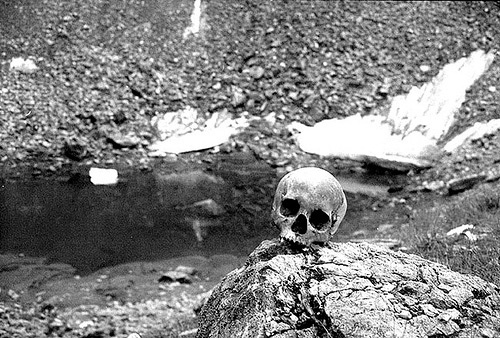Roopkund is better off known as “The skeleton lake” due to the presence of an enormous grave that holds about 300 to 600 skeletons. This discovery has revolutionized the world of ancient history ever since 1942, when a park ranger came across this mass deposition of bones. It probably is an in-accessible frozen lake that requires about four day travel to reach from the nearest locality. Recently, it has become an important spot for the visitors as they learn and conjecture this advent of science.
Through carbon dating tests, it has been experimentally estimated that these skeletons belong to anytime between 12th and 15th century. It is primarily believed that the deaths were caused by some kind of natural disaster like a blizzard, landslide or any bacterial disease. However, this topic still remains controversial among the residents, anthropologists and paleontologists of modern times.
Some went ahead to mystify the deaths with fictional possibilities and creating folklores out of it. Others suggested multiple causalities of the skeletons being those of wandering Tibetan traders who had lost their way, royal pilgrims, people committing ritualistic suicides, vanquished army etc.
More recently in 2004, a team of European and Indian scientists sent by The National Geographic Channel visited Roopkund to carry on with the probe. Their research has unearthed interesting hints and information. Part of their findings includes anthropological treasures like well-preserved corpses, jewelry, bones and skulls belonging to the dead.
By conducting DNA tests on these bodies the experts have found that the dead belonged to two different teams. One team is marked by the shorter stature of the skeletons while the other is significantly taller. The first group is thought to be of local artisans while those belonging to the second group were possibly members of the same clan, like porters.
A fresh set of radio carbon dating was carried out on the bodies to reveal that the previous dating had come up with incorrect chronological data. The dead are ascribed a new 9th century date. The scientists of London and Hyderabad examined the skulls closely to find out fractures, which they deem to be the result of an abrupt hailstorm. The hails were unusually large in volume – about the size of a tennis ball each!
No wonder that anyone exposed to such a calamity in a mercilessly open Garhwal Himalayan plain were doomed to be perished. The raw air and icy hail blasts contributed to their holocaust. It is speculated that more than one landslide has struck Roopkund ever since the massacre. This has served in burying some of the bodies inside the lake – the ones that are still found intact, preserved under ice.
Even if the dating and possible causes behind such tragic death have been hinted at, the mystery continues about a different aspect of the Skeleton Lake. It still puzzles experts to think about where these people were going. Roopkund was never a historically significant region and no traces of any trade routes have been found to Tibet nor could it possibly be a site for pilgrimage to attract large groups of people.
However, the documentary ‘Skeleton Lake’ made by the National Geographic Channel has countered this assumption. The film claimed that Roopkund was the venue for the Garhwali religious festival called ‘Nanda Jaat yatra’ held in every 12 years. A procession consisting of a newborn four-horned ram considered the familiar of a Goddess starts from the nearest village and heads towards Roopkund.
Coming back to the Skeleton Lake riddle, probably the skeletons were those of the devotees participating in such a mass procession centuries ago. The folklores say that a certain king had participated in this religious ‘yatra’ with his company of female dancers. This had offended the Goddess Nanda and she vented her rage by bringing down the snowstorm at the hapless revelers.
Such accounts might sound mere fairytales, but it is quite possible that at least the taller bodies were of royalty and the short statured bodies scattered everywhere along Roopkund were of local porters – all killed by a destructive hailstorm. Whatever may be the reason of their death – no one still knows what lead so many people to take such an arduous journey so many years ago.



 12:32 AM
12:32 AM
 crkota
crkota












 Posted in:
Posted in: 


0 comments:
Post a Comment